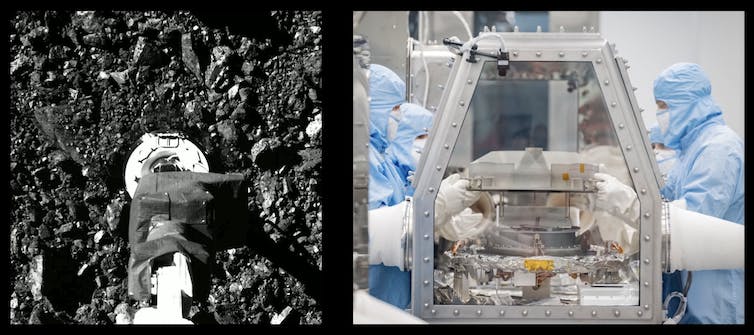NASA’s OSIRIS-REx spacecraft flew by Earth on Sept. 24, 2023, dropping off its sample of dust and pebbles gathered from the surface of near-Earth asteroid Bennu.
Analysis of this sample will help scientists understand how the solar system formed and from what sorts of materials. Scientists will begin their analysis in the same facility that analyzed rocks and dust from the Apollo lunar landings.

Left: The OSIRIS-REx spacecraft’s long metal arm with a circular end, touching the rocky asteroid surface, which is dark and covered with small pebbles. Right: Scientists opening the OSIRIS-REx sample in the astromaterials curation facility at NASA’s Johnson Space Center.
NASA/Goddard/University of Arizona and NASA/Robert Markowitz
As an astronomer studying how planets form around distant stars, I felt excited watching the broadcast of that Bennu sample descending to the Utah desert – and a little envious. Those of us who study distant young solar systems can’t send robotic spacecraft to get a closer look at them, let alone grab a sample for laboratory analysis. Instead, we rely on remote observations.
But what astronomers can measure using telescopes is not what we really want to know – instead, we calculate the properties we’re interested in studying by observing and interpreting apparent properties from afar.
Astronomers’ tools
Asteroids are like fossils – they’re composed of rocky material from the formation and early evolution of a solar system and they are preserved nearly unchanged. That’s how the pristine Bennu samples will help astronomers learn about our solar system’s formation.
Over the past several decades, astronomers have learned that disks of gas and dust called protoplanetary disks orbit young stars. Observing these disks – located many light years outside our solar system – can help astronomers understand the early planet formation process, but they’re too distant to send a sample-return mission like OSIRIS-REx to directly measure what the dust and asteroids in these systems are made of.

Left to right: Three images of protoplanetary disks TW Hydrae (Atacama Large Millimeter Array, ALMA), HD 135344B (European Southern Observatory, ESO) and 2MASS J16281370 (Hubble Space Telescope, HST).
NASA, ESA, ESO, STScI, ALMA, S. Andrews (CfA), Bill Saxton (NRAO, AUI, NSF), T. Stolker (ALMA)
All that astronomers like me can do is observe those distant regions of the universe remotely, using telescopes here on Earth or in orbit near Earth. But even with limited tools and techniques, we’ve still managed to learn quite a bit about them.
Distance and luminosity
The closest protoplanetary systems are a few hundred light years from the Sun, but we can’t directly measure distances that large. Instead, we have to determine distance indirectly using precise measurements of parallax – small changes in the apparent position of the…



